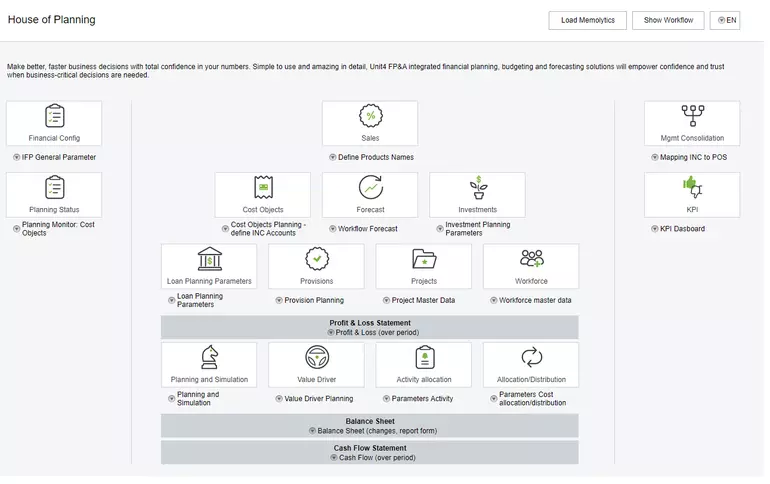
Five FP&A trends you need to spot early
Traditionally, industry-watchers usually make predictions ahead of a New Year. But today, it's essential to spot change, moment by moment. Here are five emerging trends in financial management to consider as you shape your finance strategy during 2021, moving into 2022 and beyond.
It's no surprise that artificial intelligence (AI) makes our list of financial planning & analysis (FP&A) trends. But you might be surprised at some of the other financial planning trends we've identified.
1) AI plays an increasing role in FP&A
We're familiar with the intelligent algorithms that predict the content we're likely to enjoy on social media, books we might want to buy, and films we'd probably like to watch. But AI is also hard at work in the world of finance, especially when it comes to forecasting.
Retail is a great example of how financial management trends like AI are delivering results, but more sectors are sure to take advantage of powerful AI tools soon. The opportunity to influence financial performance on the fly has huge appeal. Financial planning industry trends like these will grow rapidly and the data-crunching possibilities are almost endless.
You can see the potential with integrated financial planning (IFP) in this House of Planning visualization.

This example — showing an organization's sales — uses value-driver logic with bottom-up and top-down-planning functionalities. The next step would be to add AI forecasts, running in parallel, from dedicated AI models for sales planning. From that point onwards, finance teams could choose which values they want to use. Ultimately, AI is there to augment human intelligence, but the final decisions are always taken by people.
2) Demand grows for preconfigured FP&A models
Increasingly, organizations are viewing preconfigured FP&A models as a way to get a huge head start with implementing projects. This is among the top FP&A trends to watch. Companies can hit the ground running, saving time and money, while boosting agility.
Preconfigured models are proving highly attractive because companies can avoid defining everything from scratch. Instead, they can focus on tailoring systems for the greatest pay-off. Today, they can get FP&A best-practice models, fully integrated with ERP systems, with standardized features that can propel them 50-70% towards their goal from the outset.
Models target specific needs
Already, there are models that address specific needs within the FP&A team, such as for integrated financial planning (IFP), statutory consolidation, IFRS16, people planning and analytics (PPA), and risk management. These can be used across all industries. However, organizations operating in professional services, higher education, non-profit and the public sector can also track down models pre-configured with them in mind.
This is one of the financial management trends that looks set to continue — because it hits several business priorities at once: companies can become more responsive to change, while conserving their valuable internal resources for the areas that differentiate their business.
3) More finance leaders gaze longingly at next-gen ERP systems
Over time, finance professionals will be less interested in an individual product's capabilities, or whether a process happens within their ERP, FP&A, or another system. Instead, they'll barely be able to tell where the functionality they're consuming is coming from. There will just be one solution, and this is sure to become one of the top financial planning industry trends.
That's one reason why our next-generation cloud ERP solution — otherwise known as ERPx — will be so compelling. It reflects how the world has changed, spelling the end for cumbersome legacy applications that have been customized to oblivion. Instead, ERPx represents the new world of relentless business flexibility and anytime, anywhere applications.
Already, prominent analysts have been praising significant advances in key areas. These include singling out ERPx for the following reasons:
- ERPx has an innovative approach to handling industry standards and out-of-the-box industry-specific user experiences across people-centric verticals, according to IDC.
- It has a capability to deliver three major strategic benefits to customers: increased user productivity, reduced operational costs, and improved organizational visibility, so says Nucleus Research.
- ERPx has a people-first commitment to delivering the right experience of ERP for a specific business – going beyond the old idea of a solution that’s an 80% fit – and helping to prepare it for the future, notes Mint Jutras.
Another stand-out feature will be an "instant apps” capability – powered by machine learning. Increasingly, users will be able to evolve their business’ capabilities in real time with tools that are endlessly customizable and configurable. But here's the beauty of this capability: it requires little or no code at all. That will make ERPx hugely popular among the list of FP&A trends.
4) Finance leaders become storytellers
Forward-thinking finance leaders are now moving beyond sharing data and dashboards — they're telling stories, just like journalists. They discover critical facts about their business, craft a compelling narrative, and then deliver the headlines and options for action to their colleagues and the board.
This is all possible because their FP&A software tools let them visualize critical data easily using intuitive dashboards that contrast and compare figures over time and against forecasts. What might have taken hours to absorb, digest and interpret, can be seen in seconds. They can see the emerging trends in financial management instantly.
FP&A trends identified
Just like journalists, finance leaders can ask critical questions too and encourage others to collaborate. Colleagues in departments across the organization can access the same FP&A tools and add commentary against each data point. This essential context can explain a sudden drop in revenue, a surge a spend, or any other kind of anomaly or trend, good or bad.
Armed with the facts and the commentary, finance leaders can then create and tell the story and recommend strategic actions. They'll also be able to help the board to anticipate scenarios and plot the best course ahead.
Over coming months, many finance leaders will see their roles start to evolve this way — boosting their status and impact. On paper, they're still finance professionals, but in practice they act like investigative journalists with a nose for a story and a taste for the truth. Put simply, they'll help their colleagues to make better decisions, faster.
Financial storytelling is an emerging trend in the financial planning industry, one that looks to be here to stay.
5) Strategic simulations become a business-critical activity
Companies are getting used to more uncertain times following the arrival of the Covid-19 pandemic, the reverberations of Brexit, and any other major events that may come down the tracks. That's why the ability to plan financial scenarios and test possible outcomes will be seen as having paramount importance, and therefore a worthy addition to the leading FP&A trends.
Increasingly, organizations will be looking at the best ways to respond to volatile market conditions. This needs to be relatively simple, highly realistic, and configurable to each organization's specific needs. Tools must be able to define strategies and then show the effects on profit and loss, investments, loans, the workforce, and cash flow.
Such tools are available and fairly simple to use and customize. It's well worth watching this on-demand webinar to explore what's possible.
FP&A trends and financial planning 2021
Now we've explored the emerging trends in financial management, what are your priorities in the months ahead? Visit Unit4 and discover how you can keep pace with the latest FP&A trends.





